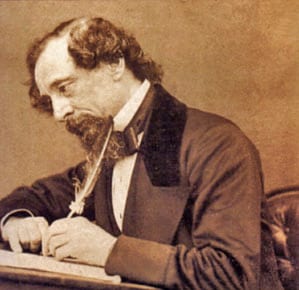The mystery of Master Humphrey
By Ruth Howells, on 14 February 2012
 In a month where you seem not to be able to switch on the television or open a newspaper without encountering something to do with Charles Dickens, this Lunch Hour Lecture fell on 7 February, the very day marking the bicentenary of the great Victorian novelist’s birth.
In a month where you seem not to be able to switch on the television or open a newspaper without encountering something to do with Charles Dickens, this Lunch Hour Lecture fell on 7 February, the very day marking the bicentenary of the great Victorian novelist’s birth.
The lecture, by Dr Matthew Beaumont (UCL English Language & Literature), fell a little off the beaten track in terms of Dickens scholarship. It focused on a peculiar and often overlooked character from perhaps one of Dickens’ less well-known and well-loved novels, The Old Curiosity Shop.
Dr Beaumont said that the novel has been neglected in scholarly terms because of its notorious sentimentality. Referring to the scenes describing the death of the saintly child Nell, Oscar Wilde famously said that, “You’d have to have a heart of stone not to laugh.”
People who have studied The Old Curiosity Shop tend to focus on the character of Quilp in the novel – the sinister, violent villain of the piece.
As Quilp is one of Dicken’s “great grotesques”, Dr Beaumont admitted that it is tempting to focus on him. The more genial Master Humphrey is a less overtly sinister presence in a novel teeming with the creepy and menacing, so easy to overlook.
Dr Beaumont’s central argument in the lecture was that Master Humphrey is not a benign geriatric – he is more sinister, with more than a whiff of the grotesque about him. In fact, Dr Beaumont suggested that he could be interpreted as Quilp’s ‘double’ in the book – a Dr Jekyll to his Mr Hyde.
Master Humphrey’s Clock was a weekly periodical edited and written by Dickens and published during 1840 and 1841. It began with a premise in which Master Humphrey and his friends gather together to tell stories. Several short stories were then included, followed by The Old Curiosity Shop. and em>Barnaby Rudge.
It is generally thought that Dickens had intended The Old Curiosity Shop to be another short story within the series, but that after a few chapters he made the decision to extend it into a novel.
Although Master Humphrey appears as the first-person narrator in the first three chapters of The Old Curiosity Shop, he abruptly and somewhat unconvincingly resigns as the narrator in the third chapter, saying: “And now that I have carried this history so far in my own character and introduced these personages to the reader, I shall for the convenience of the narrative detach myself from its further course.”
Dr Beaumont suggests that he was effectively sacked; abandoned as a device by Dickens because this slightly stilted, old, eccentric loner wasn’t up to the gear that he now wanted to shift into.
Dickens needed Dickens as the narrator. The series was waning in popularity and something had to be done to resurrect it, reinforce the novelists’s own brand and reinvigorate his career.
Dickens’s description of the new narrator as an “intrepid aeronaut…skipping through the air”, offers a stark contrast to Master Humphrey’s ambling narration.
The fact that Dickens, later in the novel, then announces that Master Humphrey has, in fact, been a character all along isn’t really in keeping with Dicken’s well-known genius in terms of the planning and execution of intricate plots.
Dr Beaumont suggested that this rather clunky turn of events was down to the intensive demands of producing a weekly serial publication, and that the composition of the novel is influenced by Dickens’s stressed state of mind and the nocturnal activity caused by his insomnia.
Dickens wrote Night Walks, a collection of essays describing his time as an insomniac, when he decided to ‘cure’ himself by walking through London in the small hours, discovering homelessness, drunkenness and vice on the streets. The antidote became something of a poison, as he found the scenes he encountered difficult to escape from.
Master Humphrey is also more at home in the night, relishing it because it is a realm of fantasy where he can wander and wonder. He is most at home in the middle of the night – even if it’s a home of guilt and darkness.
When the reader first encounters the character Nell, it is at night and the impulse is, therefore, to mistrust her. A young girl alone in the city at night had associations – either that they had already ‘fallen’ or soon would.
When Master Humphrey meets her, he takes her on an extended route just to spend more time with her. This isn’t sinister in intent, but perhaps gives a glimpse of an alternative novel – of a seduction or leading away. Master Humphrey, as a collector of human curiosities, makes the reader feel somehow compliant.
Dr Beaumont suggested a number of interesting and unsettling descendants of Master Humprey in novels by Stevenson, Joyce and Nabokov, as well as in Fritz Lang’s M.
He suggested that The Old Curiosity Shop is, at its heart, about the pursuit of the child – that Nell is pursuing Dickens.
The novelist’s state of mind, a result of commercial pressures and a punishing weekly schedule, is a real presence in a story shaped by nocturnal activity.
 Close
Close

